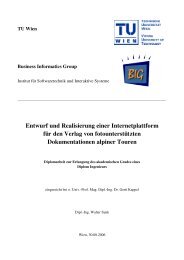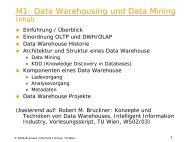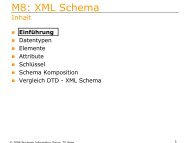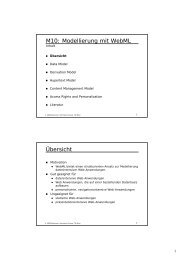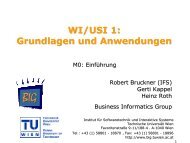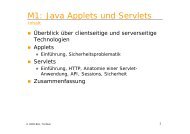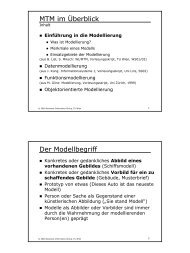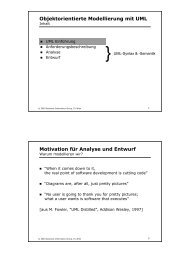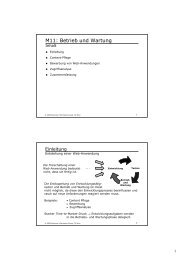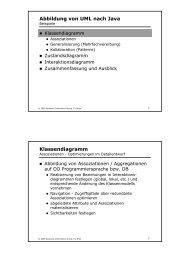Ph.D. Thesis - Business Informatics Group
Ph.D. Thesis - Business Informatics Group
Ph.D. Thesis - Business Informatics Group
You also want an ePaper? Increase the reach of your titles
YUMPU automatically turns print PDFs into web optimized ePapers that Google loves.
M3<br />
M2<br />
M1<br />
Wiss. Beiträge der Arbeit<br />
ML X<br />
L A<br />
M 1<br />
Part I<br />
Mining Pattern<br />
DTD2MOF Framework<br />
ML Y<br />
L A ‘<br />
M 1 ‘<br />
Part III<br />
-) AspectCAR<br />
-) ProfileGen<br />
L B<br />
M 2<br />
L EXT<br />
Legend<br />
Part II<br />
Framework for Building Mapping Operators<br />
CAR Mapping Language<br />
For each chapter:<br />
1. Concepts<br />
2. Solution/Implementation<br />
3. Case Study<br />
Chapter 1 Introduction<br />
Correspondence<br />
Transformation<br />
Instance-Of<br />
Extension<br />
Figure 1.4: Contribution and Supported Integration Scenarios of this <strong>Thesis</strong><br />
lem in the area of integrating modeling tools for web applications. For this, we present<br />
an integration scenario from the MDWEnet project [VKC + 07], the integration of WebRatio 8<br />
which is a CASE tool for the web modeling language WebML [CFB + 03] developed at the<br />
Politecnico de Milano with VisualWade 9 another prominent web modeling tool supporting<br />
the language OO-H [GCP01] as well as an UML tool, the Rational Software Modeler 10 from<br />
IBM.<br />
The first problem which has to be solved is that WebRatio employs XML technologies<br />
such as Document Type Definitions (DTD) for defining its supported language WebML and<br />
XML documents for storing WebML models persistently. Therefore, the DTD2Ecore Framework<br />
is needed to generate, first a metamodel for WebML out of the DTD, and second, to<br />
generate a WebRatio tool adapter which is capable of transforming WebML documents into<br />
WebML models. In particular, the WebRatio tool adapter is able to bridge the XML technical<br />
space with the model technical space [KAB02]. As soon as the WebML metamodel is generated,<br />
the user can define a mapping model between the WebML and OO-H metamodel.<br />
This mapping model can be executed within the Metamodel Bridging Framework which is capable<br />
of generating an OO-H model out of the WebML model. Finally, a mapping model can<br />
be also defined between the WebML metamodel and the UML metamodel. This mapping<br />
model is used as input for the ProfileGen component to produce, first an UML profile for<br />
WebML, and second, a transformation expressed in the ATLAS Transformation Language<br />
(ATL) [JK06] which is capable of producing from the WebML model an UML model which<br />
8 www.webratio.com<br />
9 www.visualwade.com<br />
10 www-306.ibm.com/software/awdtools/modeler/swmodeler<br />
12



